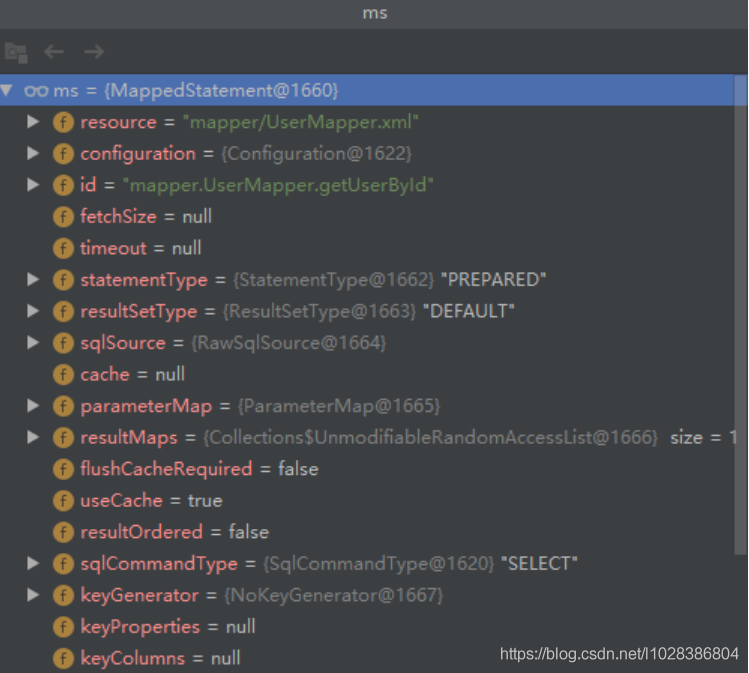User user = userMapper.getUserById(1)调用invoke代理方法
由于所有的 Mapper 都是 MapperProxy 代理对象,所以任意的方法都是执行MapperProxy 的invoke()方法。
public Object invoke(Object proxy, Method method, Object[] args) throws Throwable {
try {
//判断是否需要去执行SQL还是直接执行方法
if (Object.class.equals(method.getDeclaringClass())) {
return method.invoke(this, args);
//这里判断的是接口中的默认方法Default等
} else if (isDefaultMethod(method)) {
return invokeDefaultMethod(proxy, method, args);
}
} catch (Throwable t) {
throw ExceptionUtil.unwrapThrowable(t);
}
//获取缓存,保存了方法签名和接口方法的关系
final MapperMethod mapperMethod = cachedMapperMethod(method);
return mapperMethod.execute(sqlSession, args);
}调用execute方法
咱们的例子用的是查询所以走的是else。
public Object execute(SqlSession sqlSession, Object[] args) {
Object result;
//根据命令类型走不行的操作command.getType()是select
switch (command.getType()) {
case INSERT: {
Object param = method.convertArgsToSqlCommandParam(args);
result = rowCountResult(sqlSession.insert(command.getName(), param));
break;
}
case UPDATE: {
Object param = method.convertArgsToSqlCommandParam(args);
result = rowCountResult(sqlSession.update(command.getName(), param));
break;
}
case DELETE: {
Object param = method.convertArgsToSqlCommandParam(args);
result = rowCountResult(sqlSession.delete(command.getName(), param));
break;
}
case SELECT:
if (method.returnsVoid() && method.hasResultHandler()) {
executeWithResultHandler(sqlSession, args);
result = null;
} else if (method.returnsMany()) {
result = executeForMany(sqlSession, args);
} else if (method.returnsMap()) {
result = executeForMap(sqlSession, args);
} else if (method.returnsCursor()) {
result = executeForCursor(sqlSession, args);
} else {
//将参数转换为SQL的参数
Object param = method.convertArgsToSqlCommandParam(args);
result = sqlSession.selectOne(command.getName(), param);
if (method.returnsOptional()
&& (result == null
|| !method.getReturnType().equals(result.getClass()))) {
result = Optional.ofNullable(result);
}
}
break;
case FLUSH:
result = sqlSession.flushStatements();
break;
default:
throw new BindingException("Unknown execution method for: " + command.getName());
}
if (result == null && method.getReturnType().isPrimitive() && !method.returnsVoid()) {
throw new BindingException("Mapper method '" + command.getName()
+ " attempted to return null from a method with a primitive return type (" + method.getReturnType() + ").");
}
return result;
}调用selectOne其实是selectList
selectone查询一个和查询多个其实是一样的
public <T> T selectOne(String statement, Object parameter) {
// Popular vote was to return null on 0 results and throw exception on too many.
List<T> list = this.selectList(statement, parameter);
if (list.size() == 1) {
return list.get(0);
} else if (list.size() > 1) {
throw new TooManyResultsException("Expected one result (or null) to be returned by selectOne(), but found: " + list.size());
} else {
return null;
}
}public <E> List<E> selectList(String statement, Object parameter, RowBounds rowBounds) {
try {
//从Configuration里的mappedStatements里根据key(id的全路径)获取MappedStatement对象
MappedStatement ms = configuration.getMappedStatement(statement);
return executor.query(ms, wrapCollection(parameter), rowBounds, Executor.NO_RESULT_HANDLER);
} catch (Exception e) {
throw ExceptionFactory.wrapException("Error querying database. Cause: " + e, e);
} finally {
ErrorContext.instance().reset();
}
}mappedStatements对象如图

MappedStatement对象如图

执行query方法
1.创建CacheKey
从 BoundSql 中获取SQL信息,创建 CacheKey。这个CacheKey就是缓存的Key。
public <E> List<E> query(MappedStatement ms, Object parameterObject, RowBounds
rowBounds, ResultHandler resultHandler) throws SQLException {
//创建缓存Key
BoundSql boundSql = ms.getBoundSql(parameterObject);
//key = -575461213:-771016147:mapper.UserMapper.getUserById:0:2147483647:select * from test_user where id = ?:1:development
CacheKey key = createCacheKey(ms, parameterObject, rowBounds, boundSql);
return query(ms, parameterObject, rowBounds, resultHandler, key, boundSql);
}public <E> List<E> query(MappedStatement ms, Object parameterObject, RowBounds rowBounds,
ResultHandler resultHandler, CacheKey key, BoundSql boundSql) throws SQLException {
Cache cache = ms.getCache();
if (cache != null) {
flushCacheIfRequired(ms);
if (ms.isUseCache() && resultHandler == null) {
ensureNoOutParams(ms, boundSql);
@SuppressWarnings("unchecked")
List<E> list = (List<E>) tcm.getObject(cache, key);
if (list == null) {
list = delegate.query(ms, parameterObject, rowBounds, resultHandler,key, boundSql);
tcm.putObject(cache, key, list); // issue #578 and #116
}
return list;
}
}
return delegate.query(ms, parameterObject, rowBounds, resultHandler, key, boundSql);
}2.清空本地缓存
public <E> List<E> query(MappedStatement ms, Object parameter, RowBounds
rowBounds, ResultHandler resultHandler, CacheKey key, BoundSql boundSql) throws SQLException {
ErrorContext.instance().resource(ms.getResource()).activity("executing aquery").object(ms.getId());
if (closed) {
throw new ExecutorException("Executor was closed.");
}
//queryStack 用于记录查询栈,防止递归查询重复处理缓存
//flushCache=true 的时候,会先清理本地缓存(一级缓存)
if (queryStack == 0 && ms.isFlushCacheRequired()) {
//清空本地缓存
clearLocalCache();
}
List<E> list;
try {
queryStack++;
list = resultHandler == null ? (List<E>) localCache.getObject(key) : null;
if (list != null) {
handleLocallyCachedOutputParameters(ms, key, parameter, boundSql);
} else {
//如果没有缓存,会从数据库查询:queryFromDatabase()
list = queryFromDatabase(ms, parameter, rowBounds, resultHandler, key, boundSql);
}
} finally {
queryStack--;
}
if (queryStack == 0) {
for (DeferredLoad deferredLoad : deferredLoads) {
deferredLoad.load();
}
// issue #601
deferredLoads.clear();
//如果 LocalCacheScope == STATEMENT,会清理本地缓存
if (configuration.getLocalCacheScope() == LocalCacheScope.STATEMENT) {
// issue #482
clearLocalCache();
}
}
return list;
}3.从数据库查询
private <E> List<E> queryFromDatabase(MappedStatement ms, Object parameter,
RowBounds rowBounds, ResultHandler resultHandler, CacheKey key, BoundSql boundSql) throws SQLException {
List<E> list;
//先在缓存用占位符占位
localCache.putObject(key, EXECUTION_PLACEHOLDER);
try {
//执行Executor 的 doQuery(),默认是SimpleExecutor
list = doQuery(ms, parameter, rowBounds, resultHandler, boundSql);
} finally {
//执行查询后,移除占位符
localCache.removeObject(key);
}
//从新放入数据
localCache.putObject(key, list);
if (ms.getStatementType() == StatementType.CALLABLE) {
localOutputParameterCache.putObject(key, parameter);
}
return list;
}执行doQuery
public <E> List<E> doQuery(MappedStatement ms, Object parameter, RowBounds rowBounds,
ResultHandler resultHandler, BoundSql boundSql) throws SQLException {
Statement stmt = null;
try {
Configuration configuration = ms.getConfiguration();
StatementHandler handler = configuration.newStatementHandler(wrapper, ms,
parameter, rowBounds, resultHandler, boundSql);
stmt = prepareStatement(handler, ms.getStatementLog());
return handler.query(stmt, resultHandler);
} finally {
closeStatement(stmt);
}
}